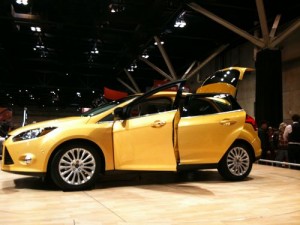Poll Results on Vehicles Per Licensed Driver
There are many ways to measure and compare regions/states on how auto-centric they are. For the poll last week I selected number of vehicles per licensed driver. The results of the poll are near the end but first I want to share other data.

Examples of vehicle miles traveled per capita in 2005:
- 1) New York City metro: 5,889.9
- 11) Chicago metro: 7,540.5
- 22) Seattle metro: 8,552.6
- 37) Wichita: 9,237.2
- 46) Minneapolis metro: 9,585.0
- 55) Austin metro: 10,220.3
- 64) Kansas City metro: 10,726.2
- 77) St. Louis metro: 11,511.4
- 88) Nashville metro: 12,275.4
- 92) Oklahoma City metro: 12,325.0
I see this as good evidence our region is too auto dependent, 76 metro areas had less vehicles miles per person than we did in 2005! But maybe we’ve peaked:
When adjusted for population growth, the number of miles driven in the United States peaked in 2005 and dropped steadily thereafter, according to an analysis by Doug Short of Advisor Perspectives, an investment research company. As of April 2013, the number of miles driven per person was nearly 9 percent below the peak and equal to where the country was in January 1995. Part of the explanation certainly lies in the recession, because cash-strapped Americans could not afford new cars, and the unemployed weren’t going to work anyway. But by many measures the decrease in driving preceded the downturn and appears to be persisting now that recovery is under way. The next few years will be telling. (New York Times)
Even if we’ve declined since 2005 like everyone else, we’re still driving considerably more miles per capita than 76 other regions.
Here are the results from last week’s poll:
Q: How many vehicles per licensed driver in your household?
- One+, but less than two 33 [45.21%]
- Less than one, more than zero 21 [28.77%]
- Two+, but less than three 9 [12.33%]
- Zero 6 [8.22%]
- Three+ 4 [5.48%]
I’ll admit I broke an important rule when it comes to polls — keeping the answers uniform. It appears the readers who responded don’t have an excess of vehicles, with over 8% saying their household has zero cars per licensed driver.
— Steve Patterson
There is a minimal correlation, at best, between the number of vehicles in a household and the number of vehicles miles traveled. Most people who don’t use (or have access to) public transit have one vehicle that they drive every day. Any other vehicle is used only sporadically, either for recreation or for some specialized use (you can’t drive two at the same time!). Yes, the “extra” vehicles need to be parked somewhere, so they have the potential to (minimally?) impact the urban fabric. The real issue is the VMT’s, since there is a direct correlation between them and urban sprawl. The cities with low VMT’s on your list have thriving urban cores, while the ones with high VMT’s have cores that are weak, with many suburban employment centers, creating more suburb-to-suburb trips, which, in turn, make it more difficult to operate a viable public transit system. A more interesting / useful poll would be what our individual VMT’s are – I’d guess that mine are around 15,000 – or how far our daily commute is, round trip – I think mine is 16 miles – and whether it’s by transit or SOV – mine is, unfortunately, by SOV.
I would have to agree with JZ. If vehicles per household alone is an indication, Jay Leno is in trouble. In the 2005 study, cities such as New York and Chicago have dense urban cores AND it’s extremely expensive to own a vehicle….parking, gas, insurance…it all adds up. And much has changed since 2005…the economy tanked along with a spiked increase in gas prices. So one would think that these would drive those mile numbers down but that is countered by the fact that the number #1 and #2 vehicles sold in the US are the F series Ford Pickups and the GM’s Silverado….not exactly gas sippers. Confusing.
One would need to know what the “metro area” consist of in terms of square miles for any reasonable comparisons to be made. For example, is the New York City Metro area just downtown or are any of the surrounding boroughs included?15 miles from downtown NYC includes areas such as Secaucus, Newark, and Queens. http://www.freemaptools.com/radius-around-point.htm
In Austin, does that include Round Rock? 15 miles from downtown Austin doesn’t include Round Rock, yet many people working in downtown Austin live in Round Rock and consider themselves part of Austin. And Austin has a dense urban core.
Does St. Louis metro include Chesterfield or anything outside of the 270 ring? 15 miles from the Arch doesn’t include people in Kirkwood, Afton, or Collinsville.
And Kansas City’s 15 miles doesn’t include Lenexa or Blue Springs.
Then we can add # of vehicles, # of drivers, # of households and the costs of living, per capita income, as well as cost per transportation mile to get more accurate and usable data. Until then, this is just cherry picking data to support any position.